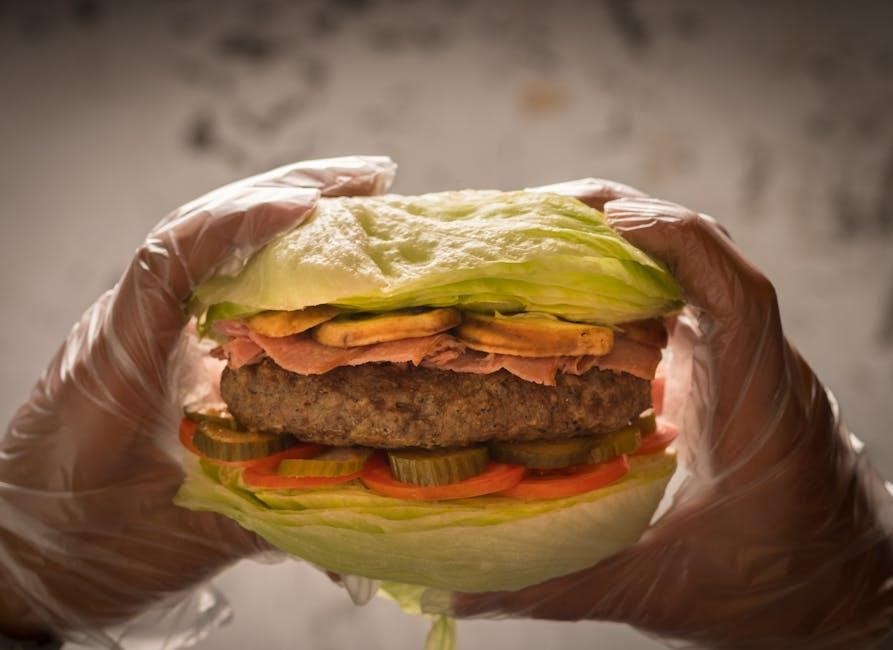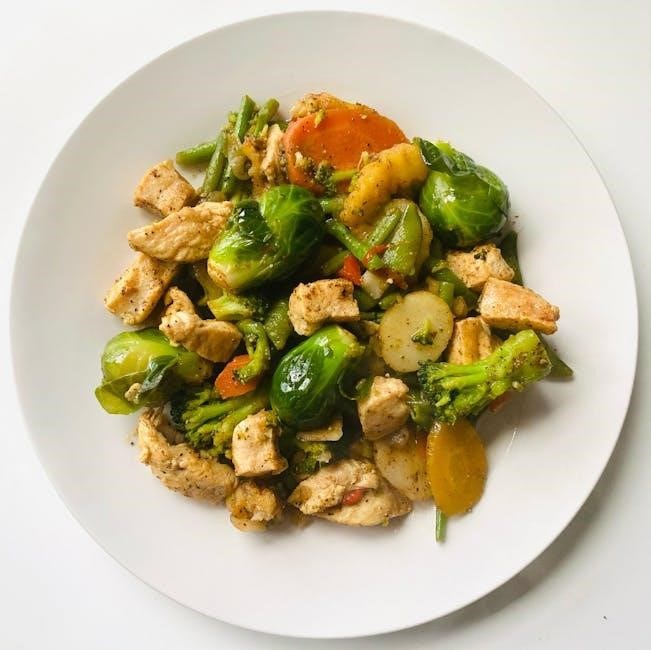Carb cycling is a dietary strategy alternating between high and low-carb days to optimize weight loss, energy, and performance․ Discover how structured meal plans and expert guidance can transform your physique and nutrition journey․
What is Carb Cycling?
Carb cycling is a dietary approach that involves alternating between high-carb and low-carb days to optimize weight loss, muscle gain, and athletic performance․ By strategically cycling carbohydrate intake, individuals aim to enhance metabolic efficiency, boost energy levels, and improve overall health․ This method allows the body to utilize different fuel sources effectively, promoting fat loss while maintaining muscle mass․ High-carb days replenish glycogen stores, supporting intense workouts, while low-carb days encourage the body to burn fat for energy․ Many free carb cycling meal plans, such as the 7-day or 12-week plans, provide structured guidance, including recipes and macronutrient breakdowns, to help individuals stick to their goals․ These plans often include expert tips, shopping lists, and customizable options, making carb cycling accessible and sustainable for various fitness and health objectives․

Benefits of Carb Cycling
Carb cycling offers numerous benefits, including weight loss, improved energy levels, and enhanced athletic performance․ By alternating carbohydrate intake, individuals can optimize fat loss while preserving muscle mass․ High-carb days provide energy for intense workouts, while low-carb days promote fat utilization․ This approach also improves metabolic efficiency, reducing the risk of plateaus․ Many users report better blood sugar control and reduced inflammation, which can aid in managing chronic diseases․ Additionally, carb cycling fosters a healthier relationship with food, eliminating strict dietary restrictions․ With free meal plans like the 7-day or 12-week carb cycling guides, achieving these benefits becomes more accessible and sustainable․ These plans often include expert tips, recipes, and shopping lists, making it easier to adhere to the diet and enjoy long-term success․

Understanding Carb Cycling
Carb cycling involves strategically rotating high and low-carb days to optimize metabolism, energy, and fat loss, tailored to individual goals and lifestyles for sustainable results․
How Carb Cycling Works
Carb cycling works by alternating between high-carb and low-carb days to manipulate your body’s fuel sources․ On high-carb days, you consume more carbohydrates to replenish glycogen stores, boosting energy for workouts and recovery․ Low-carb days shift your body to burn fat for fuel, promoting fat loss while preserving muscle․ This cycle helps avoid metabolic plateaus and supports weight loss, improved athletic performance, and better blood sugar control․ By strategically timing carbohydrate intake, you can optimize your body’s ability to use different fuel sources, enhancing overall metabolic efficiency and achieving specific health or fitness goals․ This approach is flexible, allowing customization based on individual needs, whether for weight loss, muscle gain, or enhanced endurance․
Different Carb Cycling Schedules
Carb cycling offers various schedules to suit individual goals and lifestyles․ Common approaches include alternating high-carb and low-carb days, with one day of refeeding to replenish glycogen stores․ Others prefer a block schedule, such as five high-carb days followed by two low-carb days․ Some plans incorporate no-carb days for accelerated fat loss, while others allow moderate carb intake․ The classic 6-day cycle includes high, low, and moderate days, with the seventh day for indulgence․ Additionally, a 16/8 fasting schedule combines carb cycling with time-restricted eating, further enhancing fat burning․ Customizable plans like the 12-week or 28-day meal plans provide structured guidance, ensuring adherence and progress tracking․ Each schedule can be tailored to specific needs, whether for weight loss, muscle gain, or improved athletic performance, making carb cycling a versatile and effective dietary strategy․

Creating a Carb Cycling Meal Plan

A well-structured carb cycling meal plan alternates high-carb and low-carb days, balancing macronutrients for optimal weight loss and energy․ Use free PDF guides for tailored recipes and schedules․
Macronutrient Breakdown
A carb cycling meal plan focuses on balancing macronutrients to support weight loss and performance․ On high-carb days, carbohydrates make up 50-60% of total calories, with protein at 25-30% and fats at 15-20%․ Low-carb days shift to 10-20% carbs, increasing protein to 40-50% and fats to 30-40%․ This balance ensures energy for workouts and fat burning․ Free PDF guides often provide detailed breakdowns, helping users track intake and stay on target․ Adjustments can be made based on individual goals, such as muscle gain or endurance․ Consulting a nutritionist ensures the plan is personalized and effective, optimizing results while maintaining nutritional balance․
High-Carb vs․ Low-Carb Days
High-carb days focus on replenishing energy stores and supporting intense workouts, with meals rich in whole grains, fruits, and starchy vegetables․ These days typically include 50-60% carbs, 25-30% protein, and 15-20% fats․ In contrast, low-carb days prioritize fat burning, with meals centered around lean proteins, healthy fats, and non-starchy vegetables, reducing carbs to 10-20% of total calories․ Free carb cycling meal plans often outline specific food lists for each day, ensuring balanced nutrition․ For example, high-carb days might feature oatmeal or sweet potatoes, while low-carb days include options like grilled chicken or fish․ Timing high-carb days around workouts maximizes performance, while low-carb days enhance fat metabolism․ This strategic alternation is designed to optimize body composition and energy levels, making it a flexible approach for weight loss and fitness goals․

Sample 7-Day Carb Cycling Meal Plan
This structured 7-day plan alternates high, moderate, and low-carb days, providing balanced meals, snacks, and macronutrient breakdowns to support weight loss and fitness goals effectively;
High-Carb Day Meals
High-carb days are designed to replenish energy stores and support muscle growth․ Meals typically include complex carbs like whole grains, fruits, and starchy vegetables․ Breakfast might feature oatmeal with berries and nuts, while lunch could include quinoa salads or sweet potato-based dishes․ Dinner often consists of brown rice, lean proteins, and roasted vegetables․ Snacks like bananas, apples, or yogurt with granola are also common․ Protein and healthy fats are included to maintain balance, ensuring sustained energy and satisfaction․ Hydration is emphasized, and portion sizes are adjusted based on individual goals․ These meals are strategically planned to maximize performance during workouts and support overall weight management․ By focusing on nutrient-dense foods, high-carb days help fuel the body for optimal results in a carb cycling program․
Low-Carb Day Meals
Low-carb days focus on reducing carbohydrate intake to promote fat burning and weight loss․ Meals emphasize protein-rich foods, healthy fats, and non-starchy vegetables․ Breakfast might include scrambled eggs with avocado and spinach, while lunch could feature grilled chicken or fish salads with leafy greens․ Dinners often consist of lean meats, such as turkey or steak, paired with cauliflower rice or zucchini noodles․ Snacks like hard-boiled eggs, cheese, or veggies with low-carb dips are recommended․ The goal is to keep carbs minimal, typically under 50 grams per day, while maintaining adequate protein and fat intake for satiety and energy․ These meals are designed to support metabolic shifts, enhancing the body’s ability to use fat as fuel during low-carb phases of the cycle․

Advanced Carb Cycling Strategies
Advanced carb cycling involves techniques like refeeding days and carb loading to enhance fat loss and performance․ These strategies are detailed in comprehensive meal plans for optimal results․
Refeeding Days
Refeeding days are strategically incorporated into carb cycling to replenish glycogen stores and boost metabolism․ These days involve higher carbohydrate intake, typically after a period of low-carb consumption, to prevent metabolic slowdown and maintain energy levels․ They are crucial for long-term success, as they help avoid plateaus and support overall health․ Many free carb cycling meal plans, such as the 7-day or 12-week PDF guides, include refeeding days to optimize results․ By carefully planning these days, individuals can enhance fat loss while preserving muscle mass․ Refeeding also helps manage hunger and cravings, making the diet more sustainable․
Carb Loading Techniques
Carb loading is an advanced strategy used to maximize glycogen storage and enhance performance․ It involves consuming high amounts of carbohydrates before intense workouts or events․ This technique is often included in free carb cycling meal plans, such as the 7-day or 12-week PDF guides, to help athletes and fitness enthusiasts optimize their energy levels․ By timing carbohydrate intake strategically, individuals can improve endurance and delay fatigue․ Carb loading phases typically precede high-intensity activities and are tailored to specific goals․ Proper execution requires careful planning to avoid overconsumption, which can lead to weight gain․ Many resources offer detailed carb loading schedules and recipes to integrate this method effectively into a carb cycling regimen․

Common Foods in Carb Cycling
Common foods in carb cycling include whole grains, vegetables, lean proteins, and healthy fats, strategically categorized for high-carb and low-carb days in meal plans․
Best Carbohydrate Sources
The best carbohydrate sources for carb cycling include whole grains like brown rice, oats, and quinoa, along with fruits, vegetables, and legumes․ These provide sustained energy and essential nutrients․ Incorporate complex carbs such as sweet potatoes, whole-grain bread, and pasta on high-carb days for optimal performance․ Fruits like berries, apples, and bananas offer natural sugars and fiber, making them ideal for pre- or post-workout meals․ Vegetables, including broccoli, spinach, and cauliflower, are low in carbs but rich in vitamins and antioxidants, perfect for low-carb days․ Legumes like lentils and chickpeas provide a balanced mix of carbs, protein, and fiber, supporting muscle recovery․ Avoid refined and processed carbs like white bread, sugary snacks, and sodas, as they spike blood sugar levels and hinder weight loss․ Focus on whole, nutrient-dense foods to maximize the benefits of your carb cycling meal plan․
Protein and Fat Options
Protein and healthy fats are essential in a carb cycling diet, providing sustained energy and supporting muscle growth․ Opt for lean protein sources like chicken, turkey, fish, eggs, and Greek yogurt․ Fatty fish such as salmon and tilapia are excellent for their omega-3 fatty acids․ Plant-based options include tofu, tempeh, and legumes․ Healthy fats like avocados, nuts, seeds, and olive oil are crucial for hormone production and satiety․ On low-carb days, increase your fat intake to compensate for reduced carbohydrate calories․ Prioritize whole, unprocessed foods to ensure nutrient density․ Avoid processed meats and fried foods, as they can hinder weight loss and overall health․ Balancing protein and fats appropriately ensures you stay satisfied and support your body’s needs during both high- and low-carb phases of your meal plan․

Tracking Progress
Monitor your weight, measurements, and energy levels to assess the effectiveness of your carb cycling plan․ Adjust your macronutrient ratios as needed for optimal results․
Weight Loss Monitoring
Monitoring weight loss on a carb cycling diet involves tracking progress through regular weigh-ins, body measurements, and fat percentage assessments․ Consistency is key to seeing results, as fluctuations may occur due to water retention․ Use a food diary to ensure adherence to your meal plan and adjust carb intake based on progress․ Weekly weigh-ins provide insights into trends, helping you stay motivated and on track․ Additionally, pay attention to energy levels and overall well-being, as these indicators reflect metabolic adaptation․ By closely monitoring these metrics, you can refine your approach and achieve sustainable weight loss․ Remember, patience and consistency are crucial for long-term success with carb cycling․
Adjusting the Meal Plan
Adjusting your carb cycling meal plan is essential to ensure continued progress and adapt to your body’s needs․ Start by tracking your weight, measurements, and energy levels to identify patterns․ If weight loss plateaus, consider reducing carb intake on low-carb days or increasing physical activity․ Conversely, if muscle gain is a goal, slightly increase carb portions on high-carb days․ Refeed days can be added to replenish glycogen stores and boost metabolism; Additionally, tweak macronutrient ratios by adjusting protein and fat intake to maintain balance․ Stay flexible and willing to modify the plan based on how your body responds․ Regularly consulting with a registered dietitian or healthcare professional ensures personalized adjustments for optimal results․ Consistency and patience are key while fine-tuning your approach․
Carb cycling is a powerful approach for weight loss and muscle gain, with free meal plans offering structured guidance․ Stay consistent for lasting results․

Final Tips for Success
For optimal results with carb cycling, consistency and patience are key․ Start with a structured plan, like a free 7-day meal plan, to guide your journey․ Adjust carb intake based on progress and goals, ensuring balanced nutrition․ Incorporate refeeding days to recharge metabolism and avoid plateaus․ Pair your diet with regular exercise, especially strength training, to maximize fat loss and muscle retention․ Track macros and weigh weekly to monitor changes․ Stay hydrated and listen to your body, making adjustments as needed․ Professional guidance from a dietitian can also enhance your experience․ With dedication and the right strategy, carb cycling can lead to sustainable weight loss and improved overall health․
